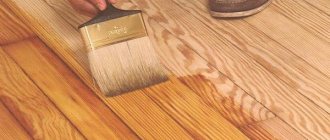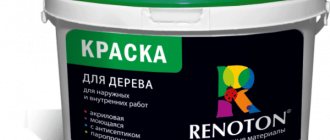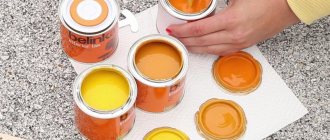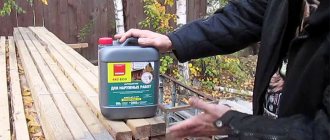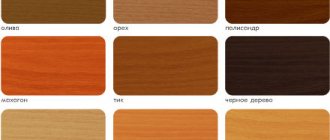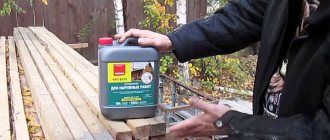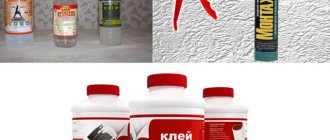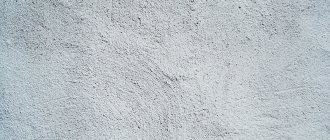Wood has not lost its popularity for many centuries, but the material has a significant drawback: its decorative properties and reliability are lost due to external factors. You can increase the durability of a wooden product by using special solutions that can create a protective barrier from external factors. Often for this purpose they choose to cover the wood with stain or varnish. The features of each product, advantages and rules for their use will be discussed in detail below.
Why do you need to stain wood?
Wood stain is a specialized composition designed for treating wood surfaces. ... Staining wood allows for its protection from moisture, rot, and damage by insects, while at the same time ensuring the preservation of its natural texture.
Interesting materials:
What foods promote collagen production? What foods strengthen memory? What foods contain fiber? What foods are included in complex carbohydrates? What products restore joints? What foods are harmful for diabetes? What foods cause cellulite? What products are prohibited for import into Russia? What foods are prohibited if you are allergic to gluten? What plants grow in the field?
Varnish and its properties
Wood varnishes are also made from different components; depending on the main substance, the properties of the coating differ. This is how compositions suitable for interior and exterior work are divided.
Special substances may be added to the varnish to provide additional protection. The main properties include:
- Moisture resistance;
- Resistance to ultraviolet rays;
- Frost resistance;
- Resistance to mechanical stress.
A film remains on the surface; it can be matte, semi-matte, or glossy. There are clear varnishes, as well as colored types that change the shade of the wood.
A film remains on the surface; it can be matte, semi-matte, or glossy.
How to make stain with your own hands?
How to make stain with your own hands?
You can prepare something like a stain at home with your own hands. Several recipes:
- For a brown shade . Grind the walnut shell into powder, put it in water, boil the powder for 10-20 minutes, strain the resulting coloring solution through a sieve and cool.
- For a reddish-brown shade . Take 200-300 g of onion peel, boil it in 1 liter of water, strain the solution through a sieve and cool.
- To lighten wood . Mix a 40% hydrogen peroxide solution and a 30% ammonia solution in a ratio of 9 to 1, mix the resulting mixture thoroughly.
Work technology
Let's now find out how to work with stain in practice.
How to apply stain
Beitz is recommended to be applied to clean wood. If there is a layer of paint or varnish on the wood, you need to get rid of it in the following ways:
- To remove old varnish, special chemical removers are used. Buy this composition at any hardware store, prepare and apply it according to the instructions.
- To get rid of a thick layer of old paint, you need to coat it with solvent and then cover the surface with cellophane. The next day you need to scrape off the soaked paint with a spatula, sandpaper or sander.
- In the case of a thin layer of paint or varnish, you can use acetone solvent. Saturate a rag with it, wet the surface, wait 5-10 minutes, and then remove the varnish or paint with a spatula.
Finishing work rules
Applying stain in general is very similar to conventional staining:
- If you apply stain to bare wood. Using a brush or spray gun, carefully apply the composition over the entire surface. When it dries (shelf life depends on the type of stain), reapply another coat of stain in a thicker layer.
- If you apply stain to stain . You can also use a brush or spray gun to re-tint. However, you only need to apply one additional coat (note, however, that it should be thick enough to cover the old stain).
Dealing with defects
If applied incorrectly, streaks and stains may appear. Let's find out how to deal with them:
- Streaks . If you notice a leak immediately after application, apply a layer of varnish over the stain. As a result, the varnish will dissolve the stain, and the mixture will turn into a thick liquid - remove it with a rag. If a leak is discovered after drying, then do exactly the same work, only use white spirit instead of varnish.
- Spots . You need to work on the same principle as with streaks - remove the stain using varnish or white spirit, apply a new layer of stain. If the stain layer is thick enough, the stain can also be removed using a plane with a well-sharpened blade.
How to remove stain
How to wash off stain
Water stain can usually be washed off with tap water. But the rest of the compositions are quite stable, so they can only be washed off with a good solvent or white spirit. Grouting must be done carefully, since the solvent will wash away both the stain and the “native” dyes. If the composition gets on clothing, it is better to throw it away, since washing will be ineffective.
Color palette
There are different colors of wood stain, and it is very difficult to answer the question of how to choose the most suitable one. This material allows you to add almost any shade to wood products. For example, black stain is very popular, which allows you to give the surface the appearance of a black mirror. It is recommended to polish the base before applying it.
Gray stain makes it possible to avoid highlighting the treated product from the overall interior. It is worth painting with it only if the walls and textiles in the interior are bright. Gray can cause depression, and products in this color will look too faded and gray.
Psychologists advise choosing a green stain (colored stain), since this shade evokes positive emotions. Green color is suitable for surface treatment of various interior items. Blue stain allows you to get a very expressive look to the finished product. Choose it to combine with yellow and white tones.
When to use varnish, when to use stain, and when to use them together
Stain for furniture, walls, floors and other surfaces is usually used to change the appearance, highlighting the natural pattern of the material, and give a more attractive tone to the surface. Often this technique helps create the effect of expensive wood.
Some compositions can impart protective properties against moisture and biological formations. However, the effectiveness of stains is low, for this reason it is recommended to use base varnish on top. Varnishes leave a film coating that does not let water in and withstands mechanical stress. For application on top, colorless types of varnishes are chosen, because the desired shade of the surface was obtained using stain.
Varnishes leave a film coating that does not let water in and withstands mechanical stress.
How to choose a stain for interior woodwork
It can be difficult for novice craftsmen to decide on the choice of stain, because there are different compositions on the construction market. When choosing a product, it is worth knowing in advance which tool will be used for application. For brushes and rollers, thicker compositions can be used; for a spray gun, viscous types will be required, which can be applied mechanically.
For interior work, types based on wax or oils are better suited; they contain fewer toxic elements than alcohol-based types.
The packaging of stains indicates the types of wood that can be processed; this factor must be taken into account when choosing an option.
For brushes and rollers, thicker compositions can be used; for a spray gun, viscous types will be required, which can be applied mechanically.
Protecting stained wood with varnish
Before applying the stain, if any, the old coating layer is removed, all types of dirt and greasy areas should be removed so that the composition can saturate the entire surface. Apply a layer with a rag or a brush, act quickly, and cover small areas so that the layer cannot be absorbed ahead of time and stains do not remain. A two-layer coating may be required, allowing each layer to dry completely.
Proceed to varnishing the base only after the stain has dried:
- The first layer of varnish is considered a primer, so the varnish is diluted with water or thinner to make a more liquid solution. Approximately 10% of the diluent of the total volume is introduced.
- When the layer dries, the surface is sanded with fine sandpaper along the grain.
- Dust generated during sanding is removed.
- Usually 2-3 layers of varnish are done to ensure an optimal effect; brushes and rollers can be used as tools; sponges can be used in difficult areas. The layer should not be too thin so that smudges do not remain.
You can apply up to six layers of varnish, but it is important to wait until the coating dries.
A two-layer coating may be required, allowing each layer to dry completely.
Varnish and stain in combination can create a durable coating that will not only look beautiful, but will also effectively protect the wood from harmful factors. The surface treatment process itself is simple; it only takes a sufficient amount of time for the layers to dry, so you can do the work yourself, without involving professionals.
Kinds
There are 2 types of the product - aqueous and non-aqueous (oil and alcohol) stain.
Water-based stain is offered by manufacturers in a ready-to-use state or as a powder (dry mixture). This type of composition is used most often because it has a very diverse range of colors. The color of powder stain can be easily adjusted; it directly depends on the amount of granular substance, that is, the more of it, the richer and brighter the result will be.
The water-based composition has the advantage: there is no unpleasant odor, thanks to which the stain can be used indoors. The disadvantages of this type include the ability of the product to lift fibers during surface treatment. Due to this, the moisture resistance of the wood is reduced. The time required for the stain to dry completely varies between 10-14 hours, which can also be attributed to the disadvantages of the type of composition.
The technology of working with water-based stain requires first wetting the wooden surface, then sanding it. The composition is filtered before use. Only after completing such preparatory work can the wood be painted. It is not advisable to use this product on resinous woods.
Oil compositions include dyes dissolved in drying oil or oils. You can work with this type of impregnation with any tool. The product does not lift the fibers of the raw material and does not allow it to become saturated with excess moisture. Using a similar composition, you can get any color and shade, additionally using dyes. They are available in powder form; white spirit is used for dilution.
According to experts, oil stain is the simplest and most convenient to use. Oil-based impregnation is very popular among decorators and decorators due to the ability to obtain the desired color.
The advantages of oil stain include its environmental friendliness, since the most common base for it is linseed oil. It takes about 2 hours for the surface to dry completely. The composition does not leave stains.
Alcohol-based stain is a dissolved aniline dye. Impregnation is available in finished or powder form. The main task of the composition is to protect wood from the destructive effects of moisture and ultraviolet radiation.
The main advantage of alcohol stain is its ability to instantly absorb into the wood fibers. The composition dries on the surface in 30-40 minutes.
The disadvantages include the fact that it will not be possible to apply the composition to wood manually, since the alcohol will evaporate very quickly, which can lead to stains. For work it is better to use a spray gun.
Along with the above types of wood stains, fundamentally new products began to appear in the assortment of construction supermarkets. Modern technologies have allowed manufacturers to offer consumers water-based acrylic impregnation, as well as a wax composition. New products were developed to eliminate the main disadvantages of existing formulations.
Wax stain is used to restore old wood coverings; it perfectly covers up color discrepancies. In addition to the above characteristics, the positive qualities of modern compositions include their excellent moisture-proof properties. However, such products are very vulnerable to mechanical damage, so they should be varnished. Acrylic and wax liquids are available in a wide variety of colors. They highlight the wood structure well.
The disadvantages of acrylic stains include their high cost, as well as the possible formation of stains on the surface when applying two or more layers.
The main disadvantage of wax compounds is that they are not able to penetrate deep into the wood. The product only forms a protective layer on top of the material. This composition should not be used before treating wood with two-component varnishes or polyurethane.
Since the composition perfectly preserves the texture of the wood and protects it from the negative influence of many external factors, thereby extending its service life, the answer to the question of what is worth purchasing - varnish or stain - becomes obvious.
